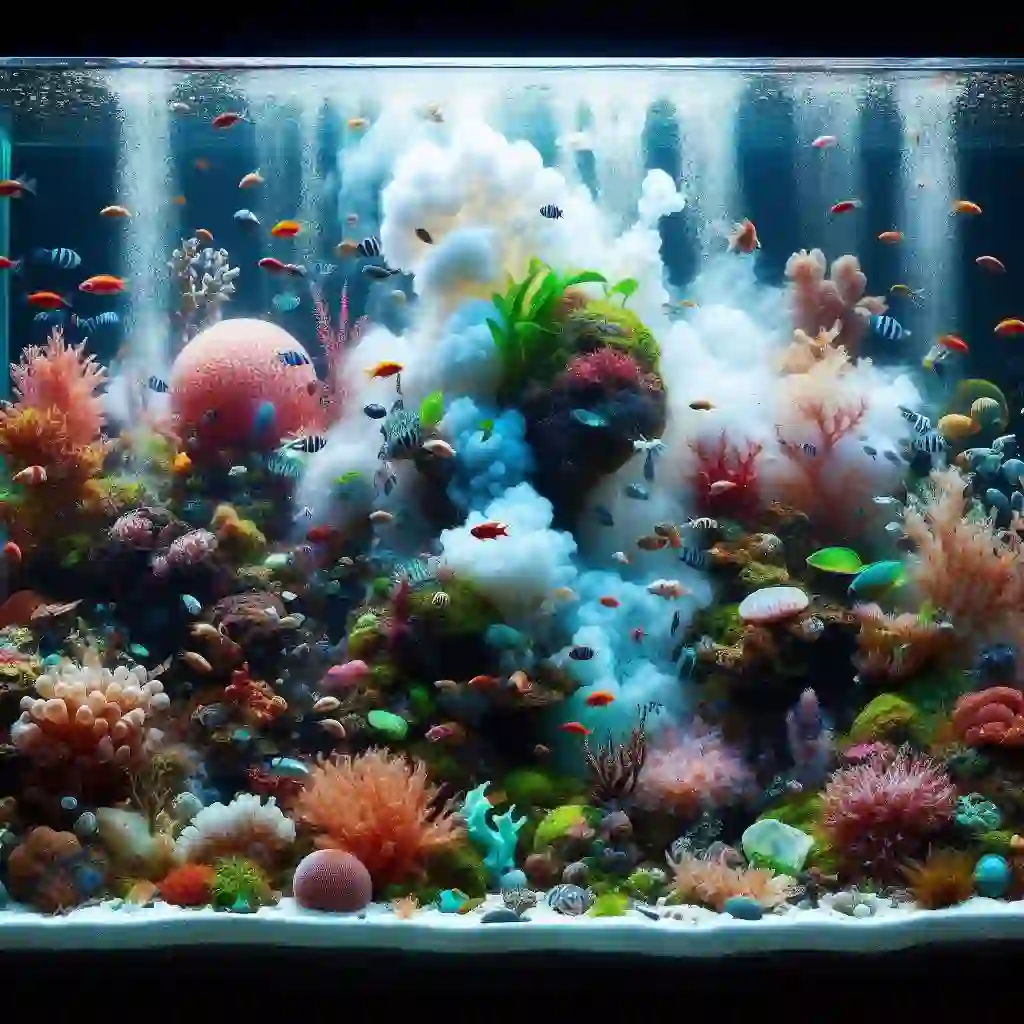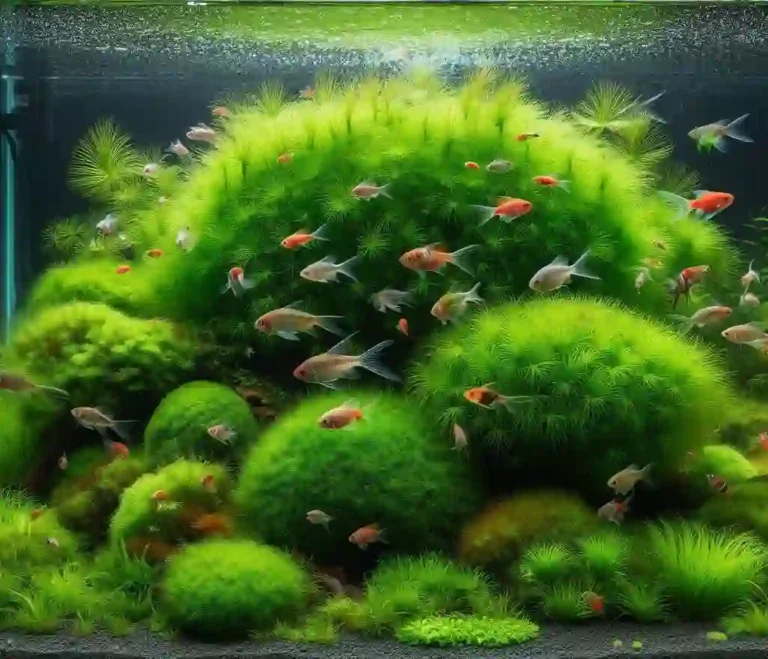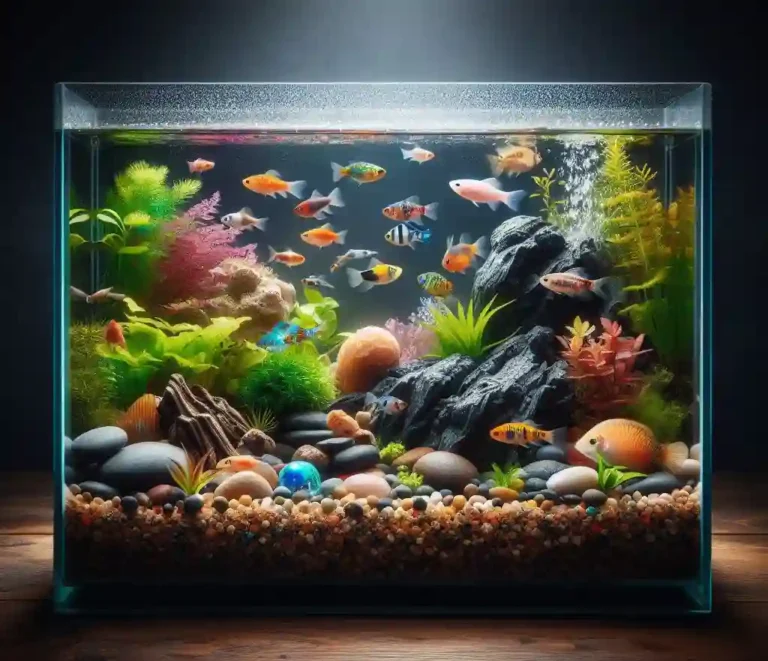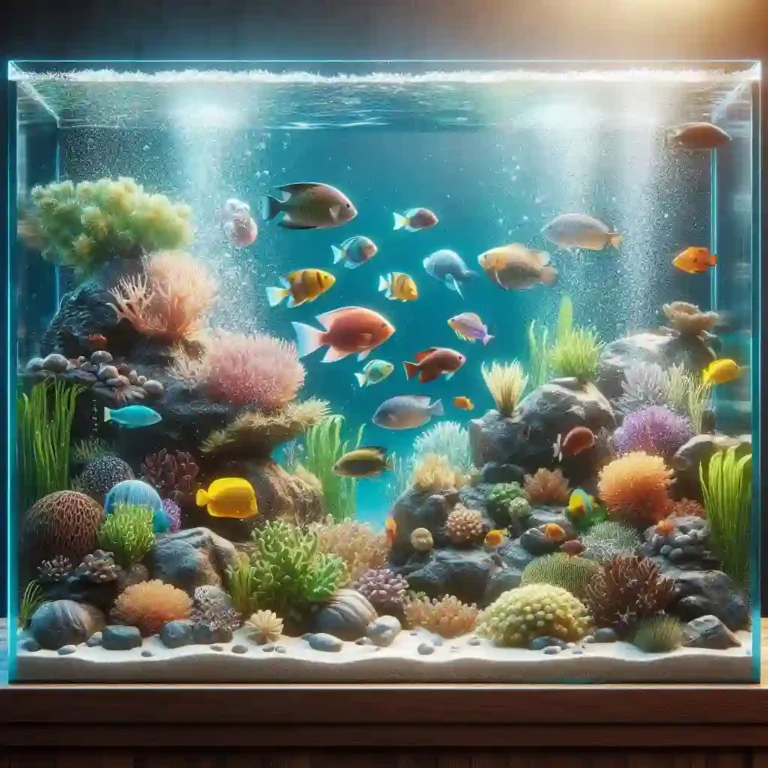Bacterial Bloom Not Going Away? Here’s What You Can Do
Bacterial Bloom Not Going Away? Are you frustrated by a persistent bacterial bloom that refuses to disappear?
Bacterial blooms can be notoriously difficult to eradicate, leaving aquarium owners and pond enthusiasts feeling helpless and unsure of what to do next. But don’t give up hope just yet!
In this article, we’ll explore the common causes of stubborn bacterial blooms and provide you with practical, actionable tips to help you finally get rid of the problem and restore your aquatic environment to its former glory.
Bacterial Bloom Not Going Away? – A Quick Guide

Why Won’t It Go Away?
- Imbalanced water chemistry
- Inadequate filtration or circulation
- Overfeeding or poor waste management
- Insufficient beneficial bacteria
- Presence of contaminants or toxins
Quick Fixes:
- Partial water change (25-50%)
- Adjust water chemistry
- Increase filtration or circulation
- Add beneficial bacteria supplements
- Reduce feeding or improve waste management
Next Steps:
- Regular water testing and maintenance
- Implement a regular water change schedule
- Upgrade filtration or circulation systems
- Introduce plants or algae-controlling measures
- Monitor and adjust feeding and waste management practices
Identify the Culprit: Common Causes of Bacterial Blooms
1. Imbalanced Water Chemistry
- pH levels that are too high or too low
- Ammonia, nitrite, or nitrate levels that are too high
- Inadequate water changes or poor water quality
2. Inadequate Filtration or Circulation
- Insufficient biological filtration
- Poor water circulation or stagnation
- Clogged or dirty filters
3. Overfeeding or Poor Waste Management
- Excess food or waste that’s not being broken down
- Inadequate waste removal or cleaning
- Overcrowding or poor stocking practices
4. Insufficient Beneficial Bacteria
- Lack of beneficial bacteria to break down waste
- Inadequate beneficial bacteria supplements
- Poor water quality that inhibits beneficial bacteria growth
5. Contamination or Toxins
- Presence of toxins or pollutants in the water
- Contamination from external sources (e.g., dirty equipment or hands)
- Poor water treatment or testing practices
Take Immediate Action: Quick Fixes for Bacterial Blooms

1. Perform a Partial Water Change (25-50%)
- Remove 25-50% of the tank water and replace it with fresh, dechlorinated water
- Repeat every 24-48 hours until the bloom subsides
2. Adjust Water Chemistry
- Test and adjust pH, ammonia, nitrite, and nitrate levels as needed
- Use water treatments or conditioners to stabilize water chemistry
3. Increase Filtration or Circulation
- Clean or replace filters to improve water flow and circulation
- Add additional filtration media or upgrade to a more efficient filter
4. Add Beneficial Bacteria Supplements
- Introduce beneficial bacteria supplements to help break down waste and toxins
- Follow product instructions for proper dosage and application
5. Reduce Feeding or Improve Waste Management
- Reduce feeding amounts or frequency to prevent excess waste
- Improve waste removal or cleaning practices to prevent accumulation
6. Monitor and Adjust Water Temperature
- Check water temperature and adjust as needed to prevent stress on aquatic life
- Maintain a stable temperature range to promote healthy bacterial growth
Balance Your Water Chemistry: The Key to a Healthy Aquatic Environment
pH Levels: The Acid-Base Balance
- Ideal pH range: 6.5-8.5
- Monitor pH levels regularly and adjust as needed
- Avoid sudden changes in pH, as this can stress aquatic life
Ammonia, Nitrite, and Nitrate: The Nitrogen Cycle
- Ammonia (NH3): toxic to aquatic life, should be 0 ppm
- Nitrite (NO2): toxic to aquatic life, should be 0 ppm
- Nitrate (NO3): should be below 20 ppm
- Monitor and adjust nitrogen levels regularly
Other Essential Water Parameters
- Water hardness (GH and KH): maintain optimal levels for aquatic life
- Water temperature: maintain a stable temperature range (e.g., 72-82°F for tropical fish)
- Oxygen levels: ensure adequate oxygenation, especially for aquatic life with high oxygen demands
Tips for Maintaining Balanced Water Chemistry
- Regular water testing: monitor water parameters regularly to catch any imbalances early
- Water changes: perform regular water changes (10-20% every week) to maintain water quality
- Avoid overfeeding: excess food can lead to water chemistry imbalances
- Provide adequate filtration: ensure your filtration system is capable of handling the biological load of your aquatic environment
Filtration and Circulation: The Dynamic Duo of Water Quality

Filtration: The Unsung Hero
- Mechanical filtration: removes particulate matter, such as food waste and debris
- Biological filtration: breaks down ammonia and nitrite, converting them into harmless nitrate
- Chemical filtration: removes toxins and excess nutrients, such as heavy metals and phosphates
Circulation: The Lifeblood of Your Aquatic Environment
- Proper circulation ensures that water is evenly distributed throughout the tank
- Prevents stagnation and promotes healthy water flow
- Helps to distribute beneficial bacteria and oxygen throughout the tank
The Importance of Proper Filtration and Circulation
- Removes waste and toxins, preventing the buildup of harmful substances
- Maintains optimal water quality, promoting healthy aquatic life
- Reduces the risk of disease and stress in aquatic life
- Helps to prevent bacterial blooms and other water quality issues
Tips for Optimizing Filtration and Circulation
- Regularly clean and maintain your filtration system
- Ensure proper water flow and circulation throughout the tank
- Monitor water quality regularly to catch any issues early
- Consider upgrading to a more efficient filtration system or adding additional circulation pumps
The Power of Beneficial Bacteria: How to Harness Their Potential
What Do Beneficial Bacteria Do?
- Break down organic waste, such as fish waste and decaying plant matter
- Convert ammonia and nitrite into harmless nitrate
- Produce enzymes that help to clarify water and reduce cloudiness
- Outcompete harmful bacteria, preventing them from multiplying
How to Encourage Beneficial Bacteria
- Provide a suitable environment: maintain optimal water temperature, pH, and oxygen levels
- Feed them: provide a source of organic matter, such as fish waste or decaying plant matter
- Avoid over-cleaning: leave some beneficial bacteria behind to colonize and thrive
- Introduce beneficial bacteria supplements: add products containing live beneficial bacteria to your tank
Tips for Maximizing Beneficial Bacteria
- Cycle your tank: allow beneficial bacteria to establish themselves before introducing fish
- Monitor water quality: regular testing helps to identify areas for improvement
- Avoid over-medication: antibiotics can harm beneficial bacteria, leading to water quality issues
- Maintain a balanced ecosystem: ensure a diverse range of aquatic life to promote beneficial bacteria growth
Feeding Frenzy: How Overfeeding Contributes to Bacterial Blooms
The Consequences of Overfeeding
- Excess food: uneaten food decays, releasing ammonia and other toxins into the water
- Nutrient overload: excess nutrients fuel the growth of algae and bacteria, leading to blooms
- Water quality issues: ammonia, nitrite, and nitrate levels can skyrocket, causing stress and disease in aquatic life
How to Avoid Overfeeding
- Monitor food intake: observe your fish to determine how much food they can consume within a few minutes
- Feed in moderation: avoid overfeeding by providing only what your fish can consume within a short period
- Choose the right food: select high-quality foods that are formulated to minimize waste and excess nutrients
- Consider automated feeders: automated feeders can help you maintain a consistent feeding schedule and avoid overfeeding
The Importance of Proper Waste Management
- Regular water changes: remove excess nutrients and waste products through regular water changes
- Efficient filtration: ensure your filtration system is capable of handling the biological load of your tank
- Beneficial bacteria: encourage the growth of beneficial bacteria to help break down waste and excess nutrients
Preventing Future Blooms: Long-Term Strategies for Success
1. Regular Water Testing and Maintenance
- Regularly test water parameters, such as pH, ammonia, nitrite, and nitrate levels
- Perform regular water changes (10-20% every week) to maintain optimal water quality
- Clean and maintain your filtration system regularly to ensure optimal performance
2. Balanced Feeding and Waste Management
- Feed your fish a balanced diet that meets their nutritional needs
- Avoid overfeeding and remove excess food to prevent waste buildup
- Implement a regular cleaning schedule to remove waste and debris from the tank
3. Beneficial Bacteria and Biological Balance
- Encourage the growth of beneficial bacteria through the use of beneficial bacteria supplements
- Maintain a balanced biological load by avoiding overcrowding and ensuring adequate filtration
- Monitor and adjust water parameters to maintain optimal conditions for beneficial bacteria growth
4. Water Circulation and Oxygenation
- Ensure adequate water circulation and oxygenation to prevent stagnation and stress
- Consider adding powerheads or adjusting water flow to improve circulation
- Monitor oxygen levels and adjust as needed to maintain optimal conditions
5. Regular Tank Maintenance and Upkeep
- Regularly clean and maintain your tank and equipment to prevent the buildup of waste and debris
- Perform regular water changes and clean the gravel and decorations to prevent the accumulation of waste
- Consider upgrading your tank or equipment to improve water quality and circulation
Getting Back on Track: Restoring Your Aquatic Environment to Health
Step 1: Identify and Address the Root Cause
- Identify the underlying cause of the bacterial bloom (e.g., overfeeding, poor water circulation, etc.)
- Take corrective action to address the root cause and prevent future blooms
Step 2: Perform a Partial Water Change
- Remove 25-50% of the tank water and replace it with fresh, dechlorinated water
- Repeat every 24-48 hours until the bloom subsides
Step 3: Optimize Water Chemistry
- Monitor and adjust water parameters (pH, ammonia, nitrite, nitrate) to optimal levels
- Perform regular water testing to ensure water quality is within acceptable ranges
Step 4: Enhance Beneficial Bacteria Growth
- Add beneficial bacteria supplements to promote the growth of beneficial bacteria
- Ensure adequate oxygenation and circulation to support beneficial bacteria growth
Step 5: Monitor and Adjust
- Regularly monitor water quality and adjust as needed
- Make adjustments to feeding, water changes, and maintenance schedules as needed
Step 6: Be Patient and Persistent
- Restoring your aquatic environment to health takes time and patience
- Stay committed to your maintenance schedule and make adjustments as needed
FAQs
Q: What is a bacterial bloom?
A: A bacterial bloom is a rapid growth of bacteria in an aquatic environment, causing cloudy or greenish water and potentially harming aquatic life.
Q: What causes bacterial blooms?
A: Bacterial blooms can be caused by a variety of factors, including overfeeding, poor water circulation, inadequate filtration, and contamination.
Q: How do I know if I have a bacterial bloom?
A: Common signs of a bacterial bloom include cloudy or greenish water, a strong ammonia smell, and a sudden increase in algae growth.
Q: How do I get rid of a bacterial bloom?
A: To get rid of a bacterial bloom, you’ll need to identify and address the underlying cause, perform partial water changes, optimize water chemistry, and enhance beneficial bacteria growth.
Q: How long does it take to get rid of a bacterial bloom?
A: The time it takes to get rid of a bacterial bloom can vary depending on the severity of the bloom and the effectiveness of your treatment strategy. With prompt action and proper care, you can start to see improvements within a few days to a week.
Q: Can I prevent bacterial blooms from happening in the future?
A: Yes, you can prevent bacterial blooms by maintaining good water quality, avoiding overfeeding, and performing regular water changes and maintenance.
Q: What are some common mistakes people make when trying to get rid of a bacterial bloom?
A: Common mistakes include not addressing the underlying cause of the bloom, not performing regular water changes, and not optimizing water chemistry.
Q: How can I prevent bacterial blooms in my aquarium or pond?
A: To prevent bacterial blooms, maintain good water quality, avoid overfeeding, perform regular water changes, and optimize water chemistry. Regularly test your water parameters and make adjustments as needed.

Hello, I’m Aria Cooper, the heart and soul behind Swimmy Buddies. As a devoted fish aficionado, I share my aquatic adventures and expertise to inspire your own underwater explorations. 🐠🌊







